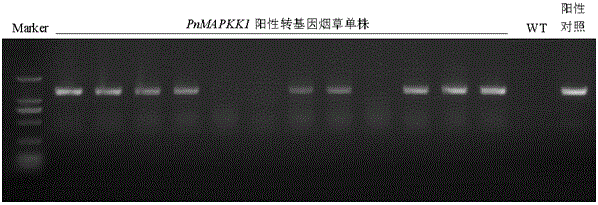Radix notoginseng mitogen-activated protein kinase kinase gene PnMAPKK1 and application thereof
A technology of mitogen activation and protein kinase, which is applied in the field of molecular biology and genetic engineering, can solve the problems of less research and achieve the effects of simple operation, shortened breeding cycle, and reduced use
- Summary
- Abstract
- Description
- Claims
- Application Information
AI Technical Summary
Problems solved by technology
Method used
Image
Examples
Embodiment 1
[0022] Example 1: PnMAPKK1 full-length cDNA cloning and sequence analysis
[0023] The root of Panax notoginseng was inoculated with Fusarium solani rot, total RNA was extracted from the root 8 hours after inoculation, the treated root of Panax notoginseng was ground into powder with liquid nitrogen, then transferred into a centrifuge tube, and extracted by guanidine isothiocyanate method total RNA. Use reverse transcriptase M-MLV (promega) to synthesize the first strand of cDNA using total RNA as a template. The reaction system and operation process are as follows: take 5 μg of total RNA, add 50 ngoligo (dT) and 2 μL dNTPMix (2.5 mMeach) in sequence, and mix with DEPC water. Make up the reaction volume to 14.5 μL; after mixing, heat denaturation at 70°C for 5 minutes, then quickly cool on ice for 5 minutes, then add 4 μL 5×First-standbuffer, 0.5 μL RNasin (200 U), 1 μL M-MLV (200 U), mix well and Centrifuge briefly, incubate at 42°C for 1.5h, take it out and heat at 70°C for...
Embodiment 2
[0026] Embodiment 2: plant overexpression vector construction
[0027] The E. coli plasmid pGEM-T-PnMAPKK1 inserted into PnMAPKK1 and the plant expression vector pCAMBIA2300S plasmid were extracted using the SanPrep column plasmid DNA mini-extraction kit (Shanghai Sangong), and 1 μL was used for agarose gel electrophoresis to detect the extracted plasmids integrity and concentration. Restriction enzymes BamHI (TaKaRa) and Pst (TaKaRa) carried out double digestion of plasmids pGEM-T-PnMAPKK1 and pCAMBIA2300S respectively (100 μL system). The reaction system and operation process were as follows: take 20 μL pGEM-T-PnMAPKK1 and pCAMBIA2300S plasmids respectively, add 10 μL 10×Kbuffer, 4.5 μL BamHI, 5.5 μLPst , 60μLddH 2 O, after mixing, centrifuge for a short time, and place at 37°C for overnight reaction. All digested products were subjected to agarose gel electrophoresis, and then the PnMAPKK1 fragment and the large fragment of the pCAMBIA2300s vector were gel-recovered us...
Embodiment 3
[0030] Example 3: Plant genetic transformation mediated by Agrobacterium and screening of transgenic plants
[0031] The transgenic recipient in this experiment was tobacco (Nicotianatabacum L.). Tobacco seeds were soaked in 75% alcohol for 30s, washed with sterile water and washed with 0.1% HgCl 2 Soak for 8 minutes, then wash several times with sterile water, sow on 1 / 2 MS medium, culture in dark at 28°C for 5-8d, transfer to light incubator (25°C, 16h / d light) after germination, and then monthly Subculture once with MS medium.
[0032] Take out the preserved Agrobacterium LBA4404 strain containing the pCAMBIA2300S-PnMAPKK1 plasmid from the -80°C refrigerator, take 20 μL and inoculate it into 5 mL of LB liquid medium containing 50 mg / L Km and 20 mg / L rifampicin, and culture it to the culture medium at 28°C turbid. Pipette 1mL of turbid bacterial solution onto LB solid medium containing 50mg / LKm, and incubate at 28°C for 48h. Then scrape off an appropriate amount of Agrob...
PUM
| Property | Measurement | Unit |
|---|---|---|
| molecular weight | aaaaa | aaaaa |
Abstract
Description
Claims
Application Information
 Login to View More
Login to View More - R&D
- Intellectual Property
- Life Sciences
- Materials
- Tech Scout
- Unparalleled Data Quality
- Higher Quality Content
- 60% Fewer Hallucinations
Browse by: Latest US Patents, China's latest patents, Technical Efficacy Thesaurus, Application Domain, Technology Topic, Popular Technical Reports.
© 2025 PatSnap. All rights reserved.Legal|Privacy policy|Modern Slavery Act Transparency Statement|Sitemap|About US| Contact US: help@patsnap.com



